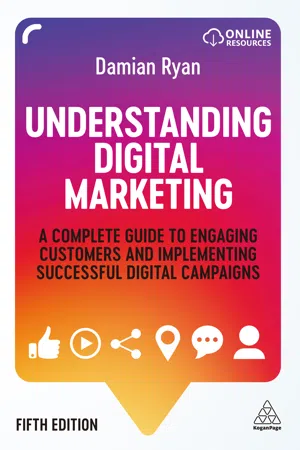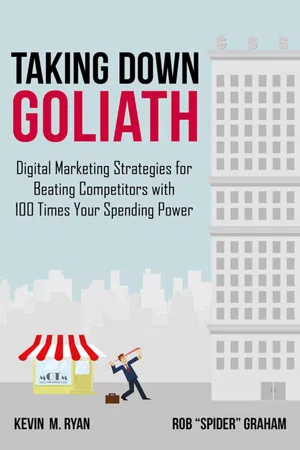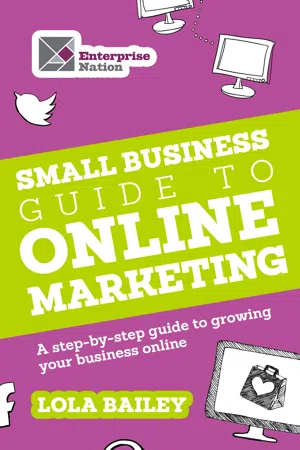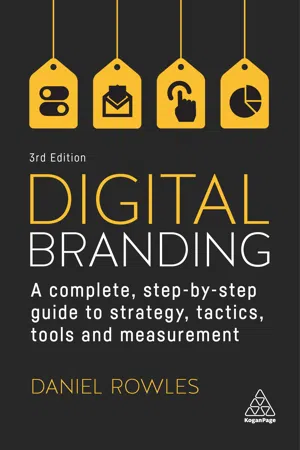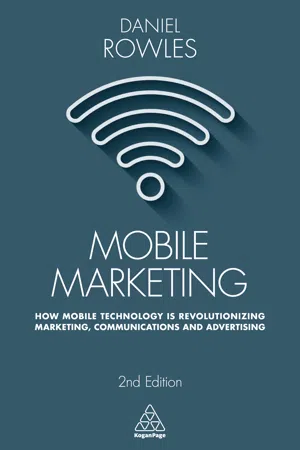Mobile Marketing
Mobile marketing refers to the practice of promoting products or services through mobile devices such as smartphones and tablets. It encompasses various strategies including mobile-optimized websites, mobile apps, SMS marketing, and location-based targeting. With the increasing use of mobile devices, mobile marketing has become a crucial aspect of reaching and engaging with consumers on the go.
8 Key excerpts on "Mobile Marketing"
- eBook - ePub
Understanding Digital Marketing
A Complete Guide to Engaging Customers and Implementing Successful Digital Campaigns
- Damian Ryan(Author)
- 2020(Publication Date)
- Kogan Page(Publisher)
...06 Mobile Marketing Our chapter pledge to you When you reach the end of this chapter you will have answers to the following questions: What is Mobile Marketing? What is the potential for Mobile Marketing? How do I go about setting up a Mobile Marketing campaign? What can Mobile Marketing do for my business? What are the top tips for building a successful Mobile Marketing campaign? What role do mobile apps play in an increasingly Mobile Marketing world? How significant are location-based apps and mobile gaming? What are the privacy issues surrounding mobile? Mobile – market size and rate of growth The Mobile Marketing Association defines Mobile Marketing in 2020 as the following: Mobile Marketing is a set of practices that enables organizations to communicate and engage with their audience in an interactive and relevant manner through any mobile device or network. Over the past decade or so, Mobile Marketing has gone from being a fairly broad advertising term to referring to a rather specific type of marketing. Once used to describe any form of marketing that made use of a moving (mobile) medium (things such as moving billboards, roadshows and other transportable outdoor advertising), today it refers to a completely different form of advertising: reaching out to connect and interact with consumers through their mobile electronic device of choice. As with other forms of online marketing, Mobile Marketing in its various guises has evolved rapidly in a relatively short space of time, fuelled by consumers with a hunger for anything that can help them to streamline their congested, hyperconnected lives...
- eBook - ePub
Business
The Ultimate Resource
- Bloomsbury Publishing(Author)
- 2011(Publication Date)
...Developing Mobile Marketing Strategies GETTING STARTED The personal nature of cell phones makes Mobile Marketing a very powerful tool. Most people take their cell phones everywhere, and they tend to read virtually every text they get—unlike junk mail, spam, or ads, which can be ignored. This makes Mobile Marketing a very attractive medium. However, it’s been held back by technological developments that have limited the type of content marketers can use. Recent developments are overcoming these limitations. FAQs Why is Mobile Marketing becoming popular? Mobile Marketing is an “accountable” medium: it has the ability to reach a specific target audience with proof that a message has been received by the user’s handset. It also provides information on how a user responded to a marketing message. Does advertising via text messaging really reach an audience? Short code messaging has become a legitimate advertising channel, as mobile operators vet every application before provisioning and monitor the service to make sure it doesn’t diverge from its original service description. A key criterion for provisioning is that the consumer opts in to the service. Mobile operators demand a double opt in from the consumer, and consumers can opt out of the service at any time by sending the word “STOP” via SMS. MAKING IT HAPPEN Realize Mobile Marketing Is the Way Forward According to industry surveys, almost 90% of major brands are planning to market their products through text and multimedia mobile messaging, and one third is planning to spend about 10% of marketing budgets through Mobile Marketing. In about five years, over half of brands are expected to spend between 5% and 25% of their total marketing budget on Mobile Marketing. Commentators believe that, like the early days of email marketing where only simple plain text messages could be delivered, Mobile Marketing has been held back by similar content delivery constraints...
- eBook - ePub
Taking Down Goliath
Digital Marketing Strategies for Beating Competitors With 100 Times Your Spending Power
- Kevin Ryan, Rob "Spider" Graham(Authors)
- 2014(Publication Date)
- Palgrave Macmillan(Publisher)
...Phones and tablets aren’t the only devices out there either. Wireless-enabled devices, such as the Apple iTouch and e-readers, have flooded the market as well. There are even plenty of smart appliances that now connect directly to the web in order to communicate with and be controlled by their owners. Before long, “smart” will be everywhere. For marketers this growth also represents incredible opportunities. But as we’ve already pointed out, in this new world advertising and marketing approaches are often limited, and some are fairly weak. On the other hand, mobile devices have created new channels for marketing and communication including social media channels and opt-in text messaging. These channels also allow marketers to ask for and receive almost instantaneous feedback on campaigns. Because of the dynamic nature of the mobile web, information can also be shared quickly by consumers and marketers to allow people to react immediately to need-driven campaigns. Perhaps at the core of the Mobile Marketing growth are branded applications. While these applications represent utility (or entertainment in many cases), they can also become effective ways of sharing brand value with consumers. They can also serve as a direct communications link between an advertiser and consumers. This is no small thing. As recently as ten years ago, the idea of companies creating a direct access channel between themselves and their customers was virtually unheard of. Obviously, there were toll-free telephone numbers and even mailing addresses that consumers with concerns or complaints could access, but the idea of companies hanging out with their customers at their level and asking them for feedback is fairly new. But this is not where the development started. Not surprisingly, early mobile marketers looked at the growing adoption of cell phones as a way to reach a new type of audience...
- eBook - ePub
The Small Business Guide to Online Marketing
A step-by-step guide to growing your business online
- Lola Bailey(Author)
- 2012(Publication Date)
- Harriman House(Publisher)
...Chapter 9: Planning for the Future – Optimising for Mobile Marketers took little notice of mobiles until the launch of the iPhone, which made Mobile Marketing a necessary reality. This in turn accelerated the development of the smartphone market, giving many people the technologies – without the expense – to access the mobile web. Source: www.flickr.com/photos/dave_fisher In this chapter you will learn: Why you should take mobile seriously: five mobile commerce and engagement statistics. The benefits of mobile technology. Ways to use mobile phones as marketing tools. How to be successful in Mobile Marketing. Why take mobile seriously? Five important statistics for mobile % of British consumers using a smartphone while shopping made a purchase either in-store, online or via a mobile. (Source: eDigital Research and IMRG Survey, 2011.) % of UK shoppers who have seen a QR code have scanned one. (Source: eDigital Research and IMRG Survey, 2011.) As many as % of UK consumers have used their mobile device for commerce, to either research or purchase a product. (Source: Global Consumer Survey from MEF, 2011.) % of UK smartphone owners report shopping from their mobile device, and 11% of these do so on a weekly basis. (Source: Portaltech and eDigitalResearch, 2011.) By, mobile internet sales is expected to reach as much as £275m, 4% of online retail spending, up from £123m in 2010. (Verdict & Ovum, 2010.) Benefits of mobile technology: Cost: Compared with the cost of production, printing and delivering direct mail, Mobile Marketing is relatively inexpensive. At the time of writing, a straightforward SMS marketing campaign costs just a few pence per text sent. Always on: We will happily turn off our radios and TVs, and we will speed past billboards. But our phones? They stay on pretty much all of the time. Data capture: Mobile campaigns are well placed to obtain data about their users...
- eBook - ePub
- Timothy Newman, Jason Peck, Brendan Wilhide(Authors)
- 2017(Publication Date)
- Routledge(Publisher)
...For example, a marketer could work with a game app and have its ad appear each time users make a certain move in the game. Two important factors to consider when creating a mobile advertising campaign are ensuring that the ads are relevant to fans and that they don’t disrupt fans’ mobile usage. Findings from a survey of mobile users conducted by Harris Interactive found that 71 percent of respondents indicated a preference for ads that allowed them to remain in the app they were using. A majority of respondents (63 percent) also expressed a preference for ads that allow them to sign up for coupons, deals, or newsletters (Pontiflex, 2010). Mobile Commerce According to the Mobile Marketing Association, mobile commerce is the one- or two-way trade for something of value achieved by a mobile electronic device. Mobile commerce is a growing trend; in 2010, one in five U.S. adult consumers reported having made a purchase in the past month (Mobile Marketing Association, 2010). Among smartphone owners, at least 41 percent had made a purchase via their phone (Siwicki, 2011). The most common mobile commerce activity is purchasing device content (e.g., ring tones and apps). The second most popular activity is a tie between using discounts and coupons and purchasing physical goods or non-mobile content and services. Purchasing tickets to events or for travel was the third most popular mobile commerce activity (Mobile Marketing Association, 2010). Consumers use their mobile devices for shopping in two ways—researching and making actual purchases. While this trend is still growing, sport marketers should take this information into account when designing mobile websites and apps. If mobile shopping continues to rise, fans will soon expect to be able to purchase tickets and merchandise directly from their phones...
- eBook - ePub
Digital Branding
A Complete Step-by-Step Guide to Strategy, Tactics, Tools and Measurement
- Daniel Rowles(Author)
- 2022(Publication Date)
- Kogan Page(Publisher)
...However, this is currently a fairly one-dimensional model that only really talks about Mobile Marketing techniques, while acknowledging that things like offline marketing may exist. Table 7.1 Discovery and engagement phases in Mobile Marketing Skip table Discovery phase Engagement phase Mobile email Mobile sites Mobile display ads Apps Mobile paid search Mobile optimized social media Mobile organic search Mobile payment and couponing Offline stimulus (QR codes, etc) Location-based interaction (near field communication, etc) Push notifications Local intent I have so far left out mentioning the local-based consumer. Not because this type of consumer is not important, but because it can be a distraction from the broader picture. If your business has any sort of location-based offering it can be immensely powerful, but this goes back to our concept of understanding the target audience’s objectives and context, and then using mobile technologies to deliver the most appropriate solution. According to Smart Insights, 92 per cent of smartphone users have their phone by their side day and night (Chaffey, 2021). If I am looking for a local hotel, my nearest bus stop, a nearby provider of power supplies for my brand of laptop and so on, this type of search is transformational to the mobile user and any potential business involved. Integrated devices Our expectations of mobile device are radically different now and smartphones and tablets offer us fully integrated computing and telecommunications devices...
- eBook - ePub
Mobile Marketing
How Mobile Technology is Revolutionizing Marketing, Communications and Advertising
- Daniel Rowles(Author)
- 2017(Publication Date)
- Kogan Page(Publisher)
...However, we first need to identify how they fit together. The line between discovery and engagement becomes increasingly blurred as we move into location-based interaction (engaging with a brand when in-store, for example), but these phases can start to lay a foundation for us when thinking about where mobile fits into the user journey. However, this is currently a fairly one-dimensional model that only really talks about Mobile Marketing techniques, whilst acknowledging that things like offline marketing may exist. Table 2.1 Discovery and engagement phases in Mobile Marketing Discovery Phase Engagement Phase Mobile e-mail Mobile sites Mobile display ads Apps Mobile paid search Mobile-optimized social Mobile organic search Mobile payment and couponing Offline stimulus (QR codes, etc) Location-based interaction (NFC etc) Push notifications Mobile and multi-channel marketing The reality of all marketing is that there generally isn’t one thing that makes you buy a product or choose a supplier. Generally, there is a huge range of factors that make you prefer one brand over another, choose a supplier or buy a particular detergent. Marketing is all about understanding this process. As marketers we can model, measure and use all sorts of tools to try and understand this buying process, and this is where digital marketing has its greatest strengths. We have access to more data and more capability to measure the user journey than ever before. However, the missing piece in this measurement puzzle has been the interaction between online and offline marketing. We’ll still face some challenges with this, but quite often mobile can act as the bridge between offline and online. Mobile Marketing will generally be part of the user journey and many other channels may be involved, some digital and some not...
- eBook - ePub
The Brain Sell
When Science Meets Shopping
- David Lewis(Author)
- 2013(Publication Date)
- Nicholas Brealey Publishing(Publisher)
...If, for example, a shopper has expressed a dislike for McDonald’s but a preference for Burger King, the message could take this into account when providing directions. By utilizing knowledge of an individual’s likes and dislikes, the cell phone is able to transform itself from useful gadget to trusted friend. Given the commercial potential of marketing, it is hardly surprising that major multinationals such as Coca-Cola, PepsiCo, McDonald’s, Kellogg’s, and Burger King are leading the way in developing mobile and location-marketing technologies. Prove endlessly persistent As any salesperson knows, when it comes to selling, persistence pays. And when it comes to being persistent, digital marketers win hands down. Mobile devices never feel snubbed or rejected and, unless programmed to do so, never take “no” for an answer. Offer anonymity While, as I explained in Chapter 5, many shoppers respond positively to the attention of a human sales assistant, on other occasions they much prefer the anonymity of digital transactions. Such confidentiality is especially important when people are purchasing items of a very personal nature. 7 Are ubiquitous Mobile devices are rapidly becoming an ever-present component of everyday life. You can find some form of digital capability embedded in cars and trucks, television sets and wristwatches, washing machines, refrigerators, and toothbrushes. This means that, in the ways I describe below, almost any appliance could be transformed into a Mobile Marketing platform. In this way, sales messages can be taken into places such as the bathroom and bedroom, where no human salesperson would be welcome. Are connected Radio-frequency identification (RFID) chips are low-cost transmitters widely used to track consumer purchases. Similar technology can also be used to introduce “ambient intelligence” into a wide range of household devices...
